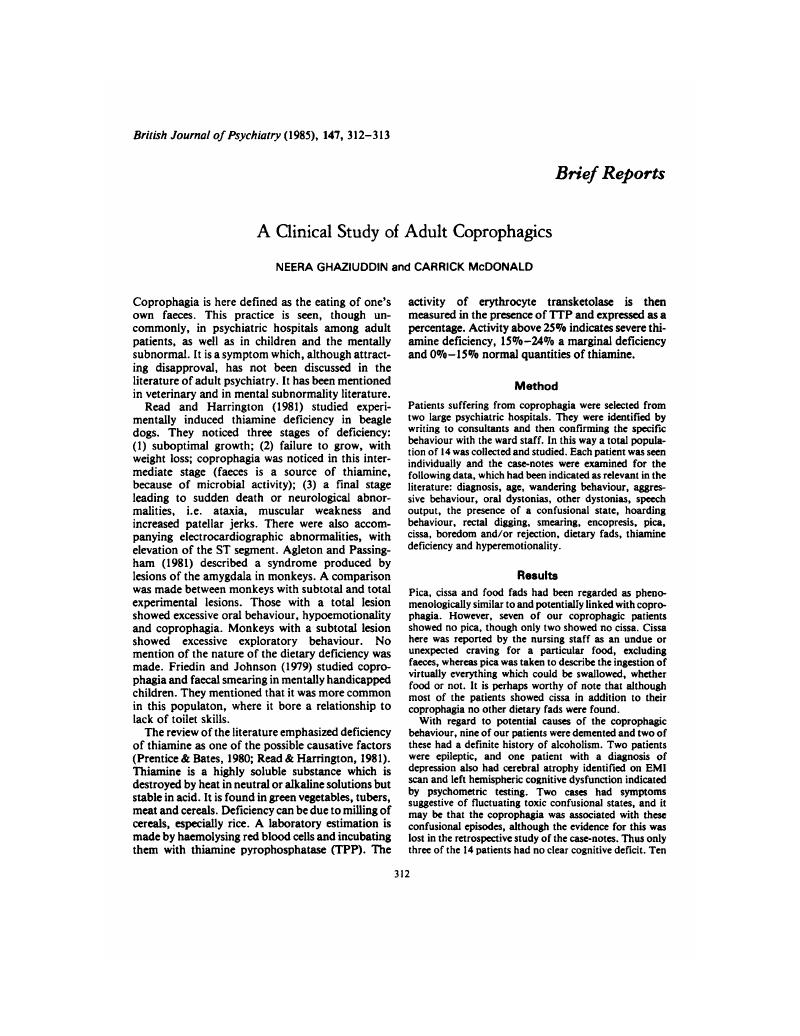Crossref Citations
This article has been cited by the following publications. This list is generated based on data provided by
Crossref.
Ruben, Susan M.
1985.
A Clinical Study of Adult Coprophagia.
British Journal of Psychiatry,
Vol. 147,
Issue. 6,
p.
734.
Nissen, Trygve
and
Haggag, Ahmed
1987.
Coprophagic behaviour in major affective disorder: A case report.
Nordisk Psykiatrisk Tidsskrift,
Vol. 41,
Issue. 3,
p.
219.
Fairburn, Christopher G.
and
Hope, R.A.
1988.
Changes in eating in dementia.
Neurobiology of Aging,
Vol. 9,
Issue. ,
p.
28.
Morris, Charles H.
Hope, R. A.
and
Fairburn, Christopher G.
1989.
Eating Habits in Dementia.
British Journal of Psychiatry,
Vol. 154,
Issue. 6,
p.
801.
McGee, Michael D.
and
Gutheil, Thomas G.
1989.
Coprophagia and Urodipsia in a Chronic Mentally Ill Woman.
Psychiatric Services,
Vol. 40,
Issue. 3,
p.
302.
Trinkle, David B.
Burns, Alistair
and
Levy, Raymond
1992.
Brief report: Abnormal eating behavior in dementia—a descriptive study.
International Journal of Geriatric Psychiatry,
Vol. 7,
Issue. 11,
p.
799.
Hope, Tony
and
Fairburn, Christopher G.
1992.
The Present Behavioural Examination (PBE): the development of an interview to measure current behavioural abnormalities.
Psychological Medicine,
Vol. 22,
Issue. 1,
p.
223.
Bugle, Charles
and
Rubin, H.B.
1993.
Effects of a nutritional supplement on coprophagia: A study of three cases.
Research in Developmental Disabilities,
Vol. 14,
Issue. 6,
p.
445.
Mayes, Linda C.
and
Volkmar, Fred R.
1993.
Nosology of Eating and Growth Disorders in Early Childhood.
Child and Adolescent Psychiatric Clinics of North America,
Vol. 2,
Issue. 1,
p.
15.
Wise, Thomas N.
and
Goldberg, Rlchard L.
1995.
Escalation of a fetish: Coprophagia in a nonpsychotic adult of normal intelligence.
Journal of Sex & Marital Therapy,
Vol. 21,
Issue. 4,
p.
272.
1995.
Treatment of coprophagia with carbamazepine.
American Journal of Psychiatry,
Vol. 152,
Issue. 2,
p.
295a.
1995.
Acute organic brain syndrome after fluoxetine treatment.
American Journal of Psychiatry,
Vol. 152,
Issue. 2,
p.
295b.
Zeitlin, Sharon B.
and
Polivy, Janet
1995.
Coprophagia as a manifestation of obsessive-compulsive disorder: A case report.
Journal of Behavior Therapy and Experimental Psychiatry,
Vol. 26,
Issue. 1,
p.
57.
MASON, T.
1996.
Scatolia: psychosis to protest.
Journal of Psychiatric and Mental Health Nursing,
Vol. 3,
Issue. 5,
p.
303.
Konrad, N.
and
Weitze, C.
1997.
Forensisch psychiatrische Begutachtung der Schuldfähigkeit bei koprophilen Handlungen an einem Minderjährigen.
Rechtsmedizin,
Vol. 7,
Issue. 2,
p.
61.
Nicholls, KR
and
Ananthanarayanan, TS
1998.
Coprophagia in association with depression and hypothyroidism.
Irish Journal of Psychological Medicine,
Vol. 15,
Issue. 2,
p.
68.
Beecroft, Nicholas
Bach, Laura
Tunstall, Nigel
and
Howard, Robert
1998.
Case report: An unusual case of pica.
International Journal of Geriatric Psychiatry,
Vol. 13,
Issue. 9,
p.
638.
Phillips, M. L.
Senior, C.
Fahy, T.
and
David, A. S.
1998.
Disgust – the forgotten emotion of psychiatry.
British Journal of Psychiatry,
Vol. 172,
Issue. 5,
p.
373.
Byard, Roger W.
2001.
Coprophagic Café Coronary.
The American Journal of Forensic Medicine and Pathology,
Vol. 22,
Issue. 1,
p.
96.
Dumaguing, Noel I.
Singh, Indra
Sethi, Mohammad
and
Devanand, D. P.
2003.
Pica in the Geriatric Mentally Ill: Unrelenting and Potentially Fatal.
Journal of Geriatric Psychiatry and Neurology,
Vol. 16,
Issue. 3,
p.
189.

eLetters
No eLetters have been published for this article.